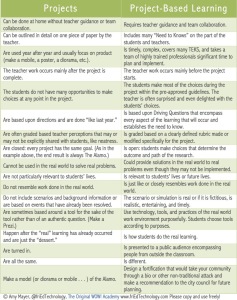There’s been some critical thinking done in recent years to analyze how we learn with projects in school. Most of us remember we had assignments in which we had very little choice of what it was or the end product. Make a diorama of a scene from your favorite book. Or make a sundial or sand clock. I remember doing a report on the Prickly Pear Cactus in 6th grade. It was the standard dig for information about what it was and where you could find it with maybe a couple of cool facts thrown in. With hobbies, I had the same way of going about it. I went looking for cool rocks in my grandmother’s gravel driveway to pass the time. Maybe I identified a rock or two, but that was it. I knew what it was and where to find it. Was that all there was that could be done with this hobby? Or project? No. Here you can implement the principles of project-based learning.
We have at our fingertips more avenues of finding information than I did back before the internet (and I won’t say how far back that was). We also have available the why and how. Why should we seek more information and how do we help our kids stretch out as they pursue their interests? The why includes such things as gaining critical thinking skills, global or societal impacts, creativity. Project-based learning emphasizes many of these skills and it does not necessarily need to be confined in a school setting.
The infographic by Amy Mayer includes those points a teacher should be considering. Many of those parts can transfer nicely to a parent. No, you don’t have to know what the TEKS are, but I’ll show you how to do the next best thing. As I mentioned, one reason why we should pursue more with our hobbies is to develop critical thinking skills. “The National Council for Excellence in Critical Thinking defines critical thinking as the intellectually disciplined process of actively and skillfully conceptualizing, applying, analyzing, synthesizing, and/or evaluating information gathered from, or generated by, observation, experience, reflection, reasoning, or communication, as a guide to belief and action.” – Wikipedia.org
When I took my kids out to eat, we saw a fire truck across the street. Obviously, my 3 year old is into trucks so we started a discussion about it. The truck turned off the sirens when it turned into the parking lot so we knew it was close to the site of an emergency. I asked if they saw any smoke and no, we did not. They parked in front of a pharmacy rather than the restaurants so we came up with reasons why they were needed there. A police car also showed up, too. Why? We couldn’t see the action from where we were so we never found out if our guesses were right, but the ideas were flowing. They took what they knew about fire trucks and police and came up with situations that may be happening to need them. My 3 year old had some funny ideas and even wrong ideas, but that was ok. This is part of developing critical thinking skills.
If your kid is a bird watcher and notices a nest made from mud, how do you find out what bird it is? You can use the internet or books to find out, but don’t stop there. Watching the birds on a regular basis and reading more about Cave Swallows can lead to more understanding, especially environmental issues, anything from the weather to predators to our own impact that we may have on their life. How? In this case, its not necessarily a bad thing. Most of the time, man can do damage to the environment to make it difficult for animals to live and reproduce, but in this case with the Cave Swallows, it seems to be the opposite. The overhanging part of bridges make excellent alternative sites for nesting. So the number of Cave Swallows have actually increased quite a bit since our transportation infrastructure has grown. Talking about why bridges work so well for Cave Swallow will bring in those critical thinking skills again.
Taking hobbies to the next level can require more work and involvement, but the benefits are there. Use what your kid is already interested in and push the boundaries of (even our own) thinking to exercise those skills necessary for success in and out of school. Incorporating project-based learning principles using those critical thinking skills, helps build the bond with your kid as well, as you spend more time in the hobby. Never forget or take for granted your impact as their first teacher.







Get Social!